Lexus GS F 2016 Owner's Manual
Manufacturer: LEXUS, Model Year: 2016, Model line: GS F, Model: Lexus GS F 2016Pages: 628, PDF Size: 8.83 MB
Page 411 of 628
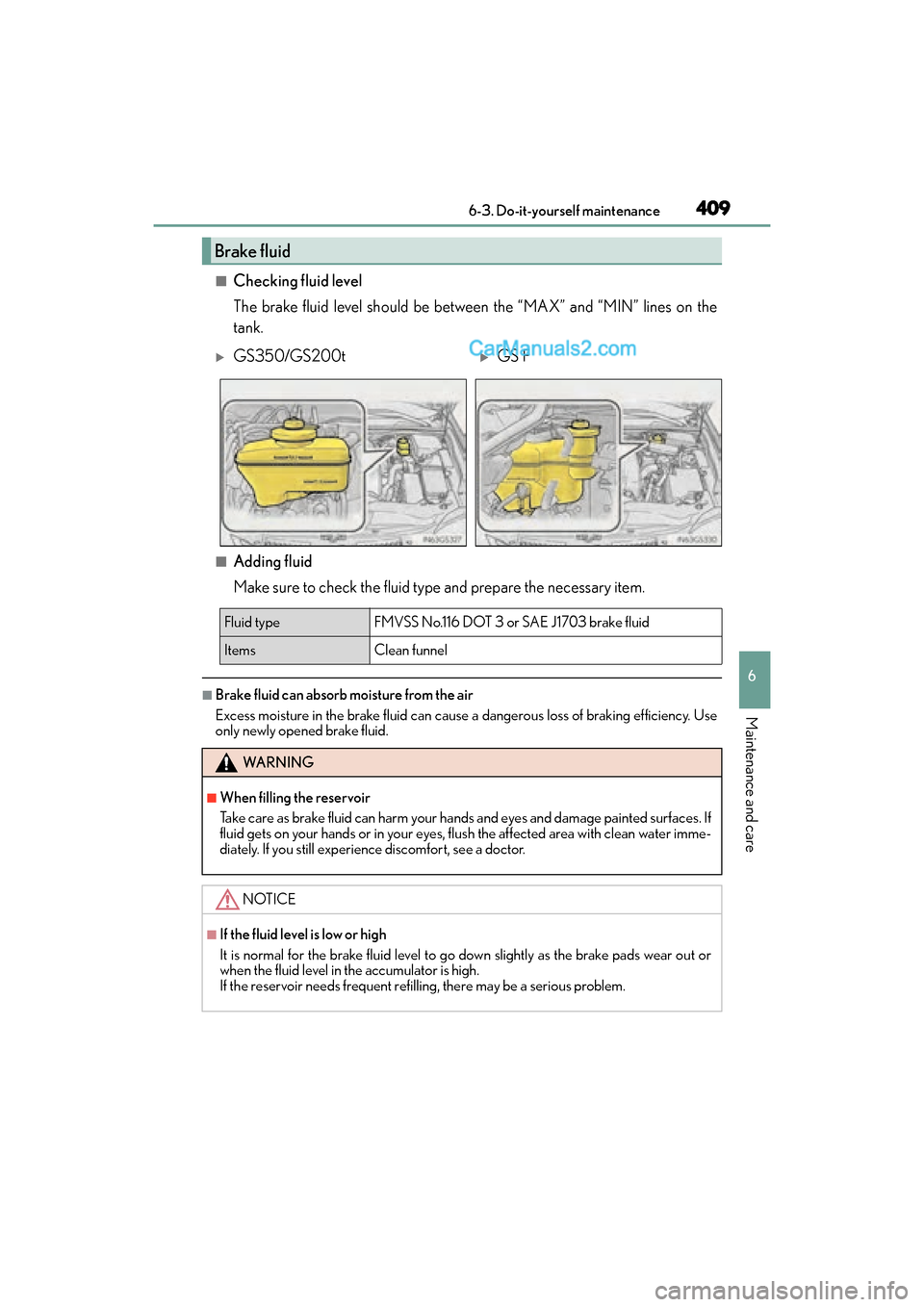
GS350_200t_GS F_OM_OM30E86U_(U)
4096-3. Do-it-yourself maintenance
6
Maintenance and care
Ō¢ĀChecking fluid level
The brake fluid level should be between the ŌĆ£MAXŌĆØ and ŌĆ£MINŌĆØ lines on the
tank.
Ō¢ĀAdding fluid
Make sure to check the fluid type and prepare the necessary item.
Ō¢ĀBrake fluid can absorb moisture from the air
Excess moisture in the brake fluid can cause a dangerous loss of braking efficiency. Use
only newly opened brake fluid.
Brake fluid
�XGS350/GS200t�XGS F
Fluid typeFMVSS No.116 DOT 3 or SAE J1703 brake fluid
Items Clean funnel
WA R N I N G
Ō¢ĀWhen filling the reservoir
Take care as brake fluid can harm your hands and eyes and damage painted surfaces. If
fluid gets on your hands or in your eyes, fl ush the affected area with clean water imme-
diately. If you still experien ce discomfort, see a doctor.
NOTICE
Ō¢ĀIf the fluid level is low or high
It is normal for the brake fluid level to go down slightly as the brake pads wear out or
when the fluid level in the accumulator is high.
If the reservoir needs frequent ref illing, there may be a serious problem.
Page 412 of 628

410
GS350_200t_GS F_OM_OM30E86U_(U)6-3. Do-it-yourself maintenance
Check the battery as follows.
Ō¢ĀBattery exterior
Make sure that the battery terminals are not corroded and that there are no
loose connections, cracks, or loose clamps.
Te r m i n a l s
Hold-down clamp
Ō¢ĀBefore recharging
When recharging, the battery produces hydrogen gas which is flammable and explosive.
Therefore, observe the following before recharging:
ŌŚÅIf recharging with the battery installed on the vehicle, be sure to disconnect the ground
cable.
ŌŚÅMake sure the power switch on the charger is off when connecting and disconnecting
the charger cables to the battery.
Ō¢ĀAfter recharging/reconnecting the battery
The engine may not start. Follow the pr ocedure below to initialize the system.
Shift the shift lever to P.
Open and close any of the doors.
Restart the engine.
ŌŚÅUnlocking the doors using the smart access system with push-button start may not be
possible immediately after reconnecting the battery. If this happens, use the wireless
remote control or the mechanical key to lock/unlock the doors.
ŌŚÅStart the engine with the engine switch in ACCESSORY mode. The engine may not
start with the engine switch turned off. However, the engine will operate normally from
the second attempt.
ŌŚÅThe engine switch mode is recorded by the vehicle. If the battery is reconnected, the
vehicle will return the engine switch mode to the status it was in before the battery was
disconnected. Make sure to turn off the engine before disconnect the battery. Take
extra care when connecting the battery if the engine switch mode prior to discharge is
unknown.
If the engine will not start even after multip le attempts at both methods, contact your
Lexus dealer.
Battery
1
2
1
2
3
Page 413 of 628

GS350_200t_GS F_OM_OM30E86U_(U)
4116-3. Do-it-yourself maintenance
6
Maintenance and care
WA R N I N G
Ō¢ĀChemicals in the battery
Batteries contain poisonous and corrosive sulfuric acid and may produce hydrogen
gas which is flammable and explosive. To reduce the risk of death or serious injury, take
the following precautions while working on or near the battery:
ŌŚÅDo not cause sparks by touching the battery terminals with tools.
ŌŚÅDo not smoke or light a match near the battery.
ŌŚÅAvoid contact with eyes, skin and clothes.
ŌŚÅNever inhale or swallow electrolyte.
ŌŚÅWear protective safety glasses when working near the battery.
ŌŚÅKeep children away from the battery.
Ō¢ĀWhere to safely charge the battery
Always charge the battery in an open area. Do not charge the battery in a garage or
closed room where there is insufficient ventilation.
Ō¢ĀHow to recharge the battery
Only perform a slow charge (5 A or less). The battery may explode if charged at a
quicker rate.
Ō¢ĀEmergency measures regarding electrolyte
ŌŚÅIf electrolyte gets in your eyes
Flush your eyes with clean water for at least 15 minutes and get immediate medical
attention. If possible, continue to apply water with a sponge or cloth while traveling to
the nearest medical facility.
ŌŚÅIf electrolyte gets on your skin
Wash the affected area thoroughly. If you feel pain or burning, get medical attention
immediately.
ŌŚÅIf electrolyte gets on your clothes
It can soak through clothing on to your skin. Immediately take off the clothing and fol-
low the procedure above if necessary.
ŌŚÅIf you accidentally swallow electrolyte
Drink a large quantity of water or milk . Get emergency medical attention immedi-
ately.
NOTICE
Ō¢ĀWhen recharging the battery
Never recharge the battery while the engine is running. Also, be sure all accessories
are turned off.
Page 414 of 628

412
GS350_200t_GS F_OM_OM30E86U_(U)6-3. Do-it-yourself maintenance
If any washer does not work or the warning message appears on the multi-infor-
mation display, the washer tank may be empty. Add washer fluid.
Washer fluid
�XGS350/GS200t�XGS F
WA R N I N G
Ō¢ĀWhen adding washer fluid
Do not add washer fluid when the engine is
hot or running as washer fluid contains
alcohol and may catch fire if spilled on the engine etc.
NOTICE
Ō¢ĀDo not use any fluid other than washer fluid
Do not use soapy water or engine antifreeze instead of washer fluid.
Doing so may cause streaking on the vehicleŌĆÖs painted surfaces.
Ō¢ĀDiluting washer fluid
Dilute washer fluid with water as necessary.
Refer to the freezing temperatures listed on the label of the washer fluid bottle.
Page 415 of 628
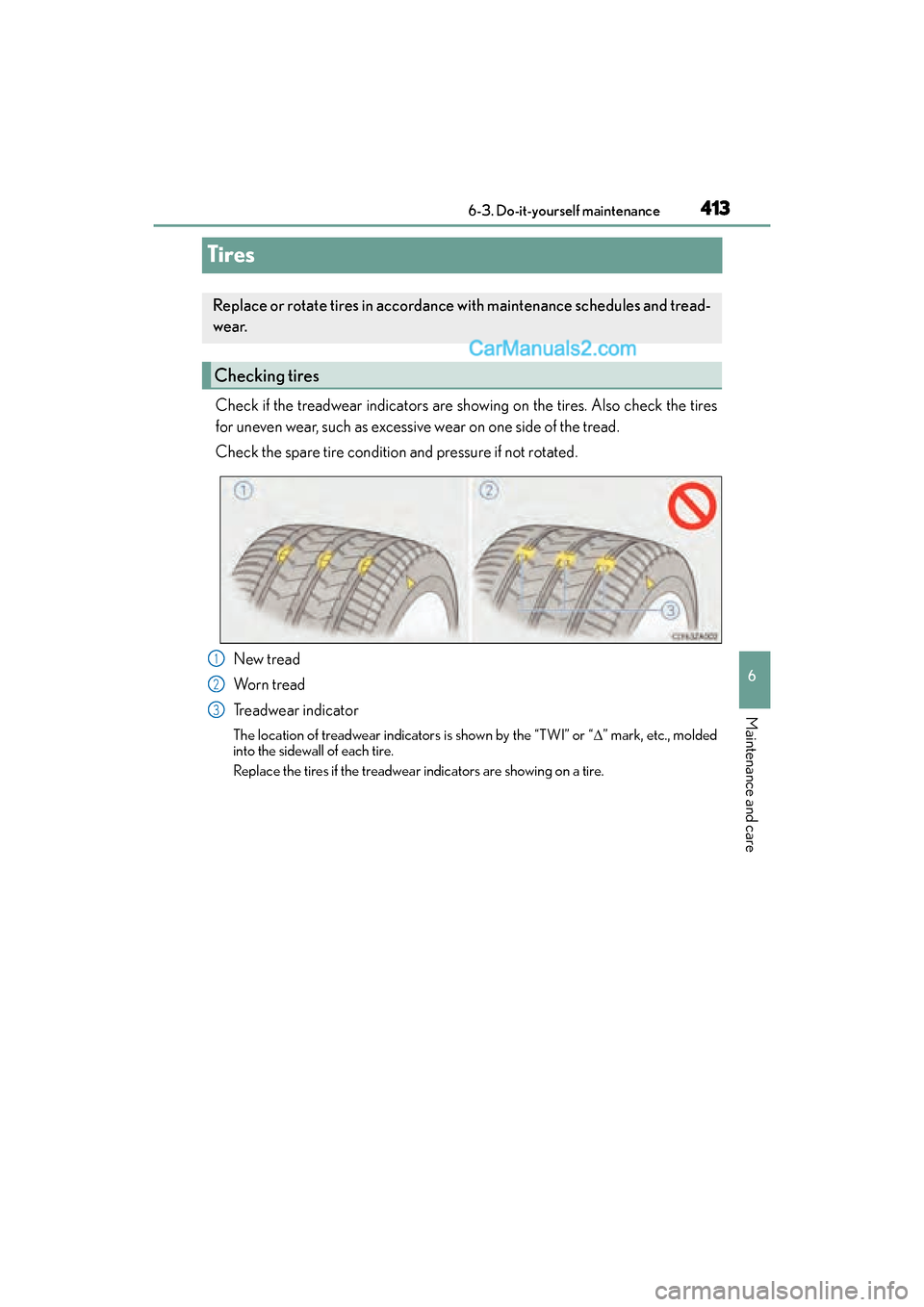
413
GS350_200t_GS F_OM_OM30E86U_(U)6-3. Do-it-yourself maintenance
6
Maintenance and care
Tires
Check if the treadwear indicators are showing on the tires. Also check the tires
for uneven wear, such as excessive wear on one side of the tread.
Check the spare tire condition and pressure if not rotated.
New tread
Wo r n t r e a d
Treadwear indicator
The location of treadwear indicators is shown by the ŌĆ£TWIŌĆØ or ŌĆ£ ŌłåŌĆØ mark, etc., molded
into the sidewall of each tire.
Replace the tires if the treadwear indicators are showing on a tire.
Replace or rotate tires in accordance with maintenance schedules and tread-
wear.
Checking tires
1
2
3
Page 416 of 628
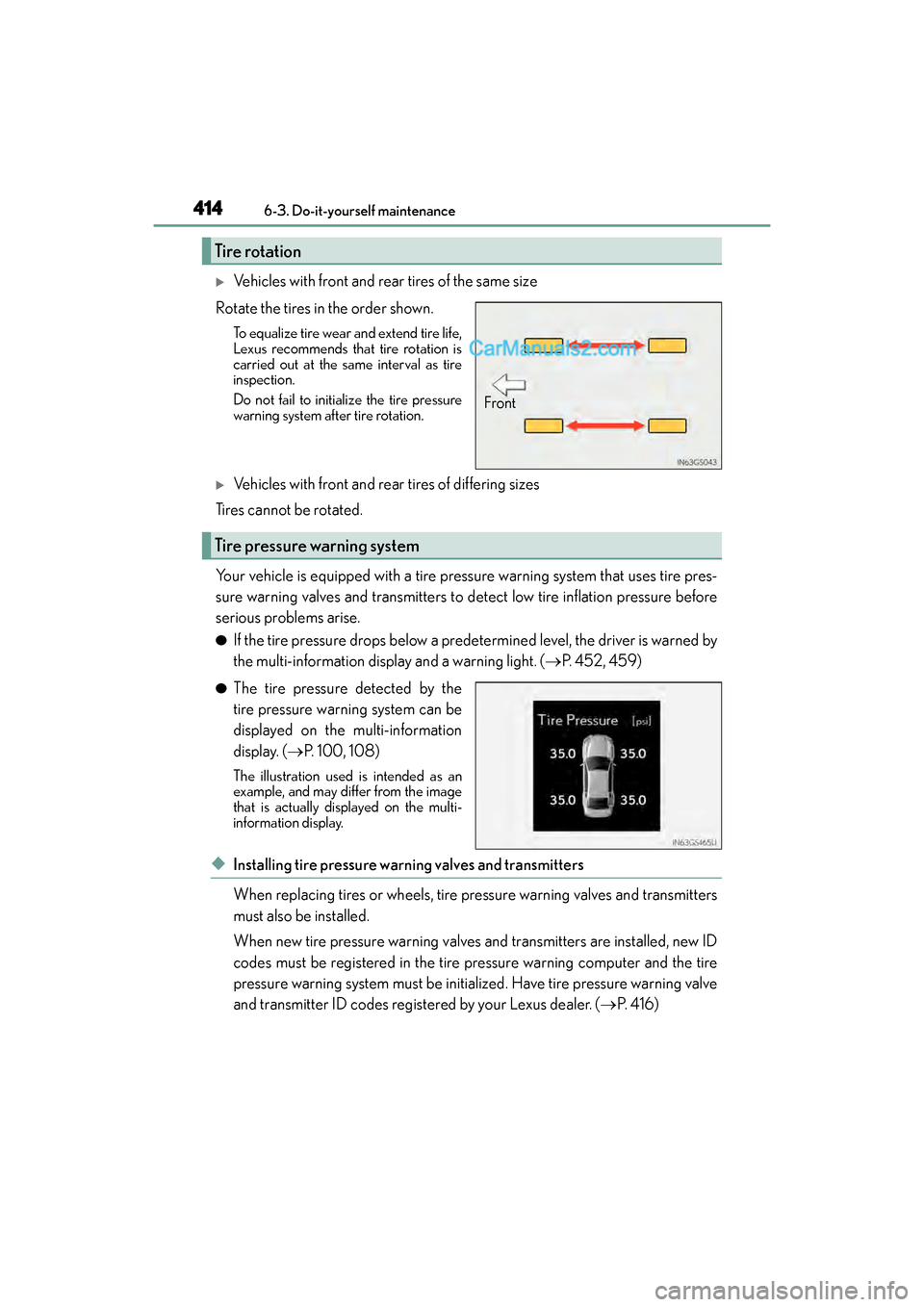
414
GS350_200t_GS F_OM_OM30E86U_(U)6-3. Do-it-yourself maintenance
�XVehicles with front and rear tires of the same size
Rotate the tires in the order shown.
To equalize tire wear and extend tire life,
Lexus recommends that tire rotation is
carried out at the same interval as tire
inspection.
Do not fail to initialize the tire pressure
warning system after tire rotation.
�XVehicles with front and rear tires of differing sizes
Tires cannot be rotated.
Your vehicle is equipped with a tire pressure warning system that uses tire pres-
sure warning valves and transmitters to detect low tire inflation pressure before
serious problems arise.
ŌŚÅIf the tire pressure drops below a predetermined level, the driver is warned by
the multi-information display and a warning light. ( ŌåÆP. 452, 459)
ŌŚÅThe tire pressure detected by the
tire pressure warning system can be
displayed on the multi-information
display. ( ŌåÆP. 100, 108)
The illustration used is intended as an
example, and may differ from the image
that is actually displayed on the multi-
information display.
ŌŚåInstalling tire pressure warning valves and transmitters
When replacing tires or wheels, tire pressure warning valves and transmitters
must also be installed.
When new tire pressure warning valves and transmitters are installed, new ID
codes must be registered in the tire pressure warning computer and the tire
pressure warning system must be initiali zed. Have tire pressure warning valve
and transmitter ID codes registered by your Lexus dealer. ( ŌåÆP. 4 1 6 )
Tire rotation
Front
Tire pressure warning system
Page 417 of 628
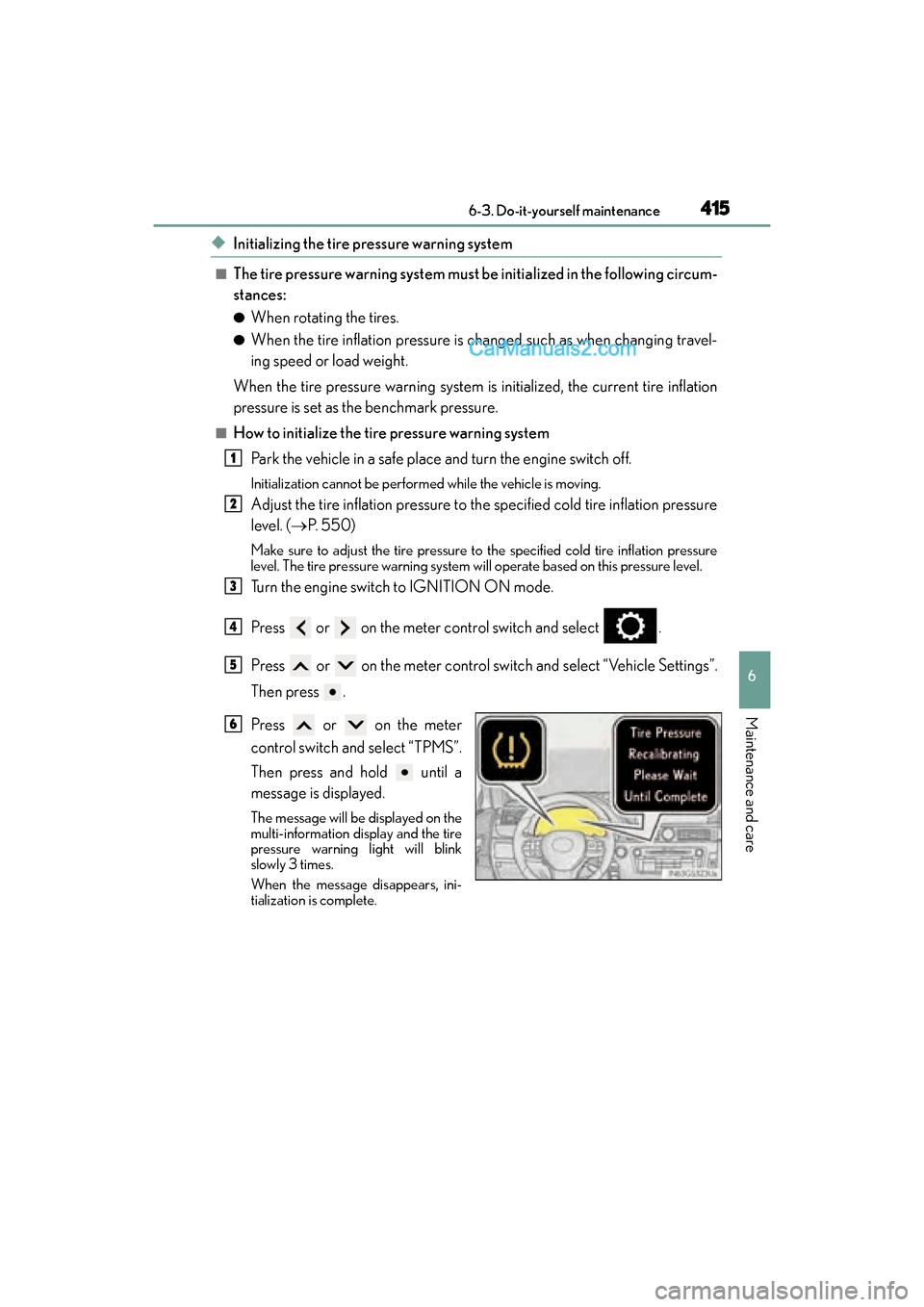
GS350_200t_GS F_OM_OM30E86U_(U)
4156-3. Do-it-yourself maintenance
6
Maintenance and care
ŌŚåInitializing the tire pressure warning system
Ō¢ĀThe tire pressure warning system must be initialized in the following circum-
stances:
ŌŚÅWhen rotating the tires.
ŌŚÅWhen the tire inflation pressure is changed such as when changing travel-
ing speed or load weight.
When the tire pressure warning system is initialized, the current tire inflation
pressure is set as the benchmark pressure.
Ō¢ĀHow to initialize the tire pressure warning system Park the vehicle in a safe place and turn the engine switch off.
Initialization cannot be performed while the vehicle is moving.
Adjust the tire inflation pressure to the specified cold tire inflation pressure
level. (ŌåÆ P. 5 5 0 )
Make sure to adjust the tire pressure to the specified cold tire inflation pressure
level. The tire pressure warning system will operate based on this pressure level.
Turn the engine switch to IGNITION ON mode.
Press or on the meter control switch and select .
Press or on the meter control switch and select ŌĆ£Vehicle SettingsŌĆØ.
Then press .
Press or on the meter
control switch and select ŌĆ£TPMSŌĆØ.
Then press and hold until a
message is displayed.
The message will be displayed on the
multi-information display and the tire
pressure warning light will blink
slowly 3 times.
When the message disappears, ini-
tialization is complete.
1
2
3
4
5
6
Page 418 of 628
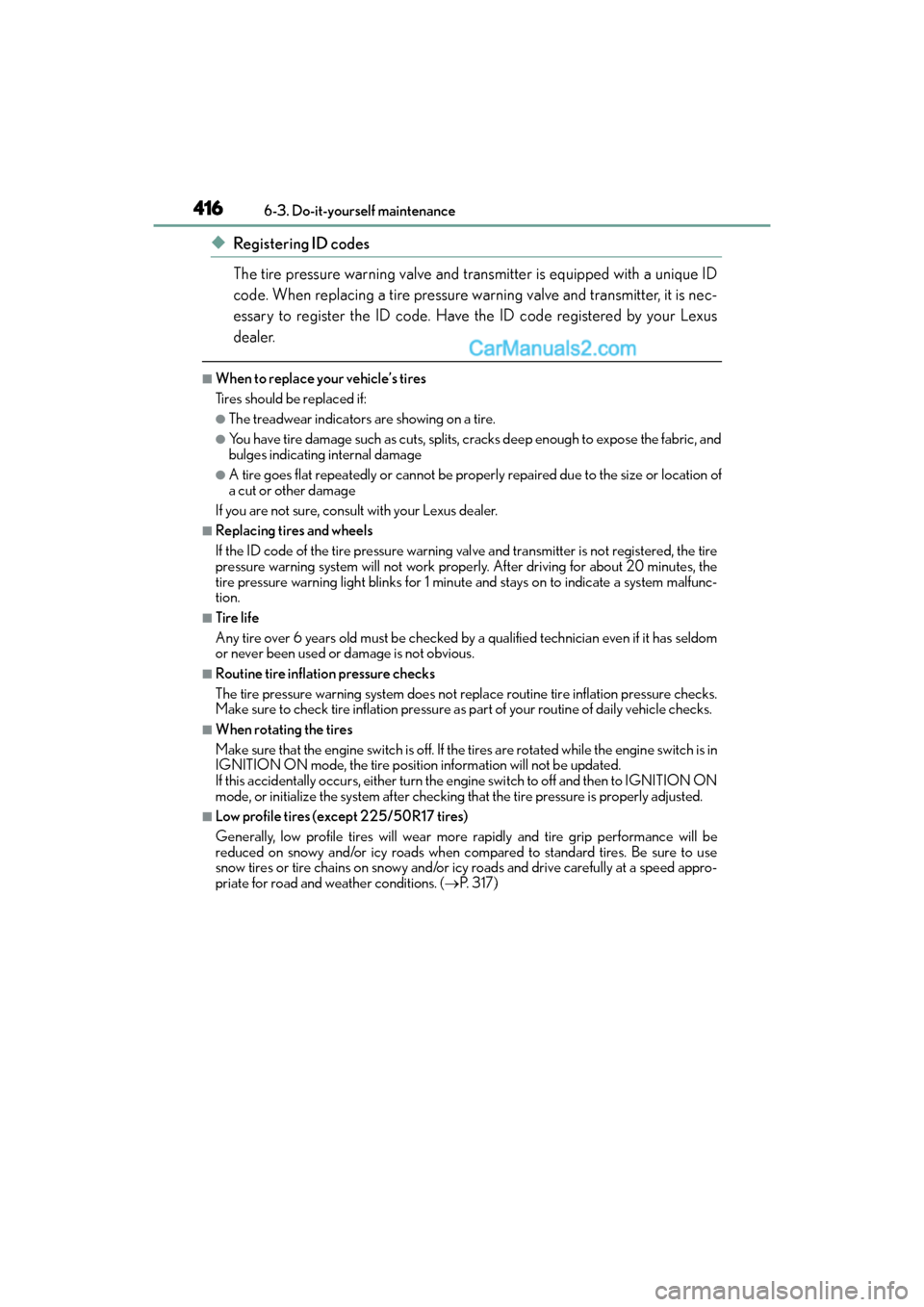
416
GS350_200t_GS F_OM_OM30E86U_(U)6-3. Do-it-yourself maintenance
ŌŚåRegistering ID codes
The tire pressure warning valve and tr
ansmitter is equipped with a unique ID
code. When replacing a tire pressure warning valve and transmitter, it is nec-
essary to register the ID code. Have the ID code registered by your Lexus
dealer.
Ō¢ĀWhen to replace your vehicleŌĆÖs tires
Tires should be replaced if:
ŌŚÅThe treadwear indicators are showing on a tire.
ŌŚÅYou have tire damage such as cuts, splits, cracks deep enough to expose the fabric, and
bulges indicating internal damage
ŌŚÅA tire goes flat repeatedly or cannot be properly repaired due to the size or location of
a cut or other damage
If you are not sure, consult with your Lexus dealer.
Ō¢ĀReplacing tires and wheels
If the ID code of the tire pressure warning valve and transmitter is not registered, the tire
pressure warning system will not work properly. After driving for about 20 minutes, the
tire pressure warning light blinks for 1 minu te and stays on to indicate a system malfunc-
tion.
Ō¢ĀTire life
Any tire over 6 years old must be checked by a qualified technician even if it has seldom
or never been used or damage is not obvious.
Ō¢ĀRoutine tire inflation pressure checks
The tire pressure warning system does not replace routine tire inflation pressure checks.
Make sure to check tire inflation pressure as part of your routine of daily vehicle checks.
Ō¢ĀWhen rotating the tires
Make sure that the engine switch is off. If the tires are rotated while the engine switch is in
IGNITION ON mode, the tire position information will not be updated.
If this accidentally occurs, either turn the engine switch to off and then to IGNITION ON
mode, or initialize the system after checking that the tire pressure is properly adjusted.
Ō¢ĀLow profile tires (except 225/50R17 tires)
Generally, low profile tires will wear more rapidly and tire grip performance will be
reduced on snowy and/or icy roads when compared to standard tires. Be sure to use
snow tires or tire chains on snowy and/or icy roads and drive carefully at a speed appro-
priate for road and weather conditions. ( ŌåÆP. 3 1 7 )
Page 419 of 628
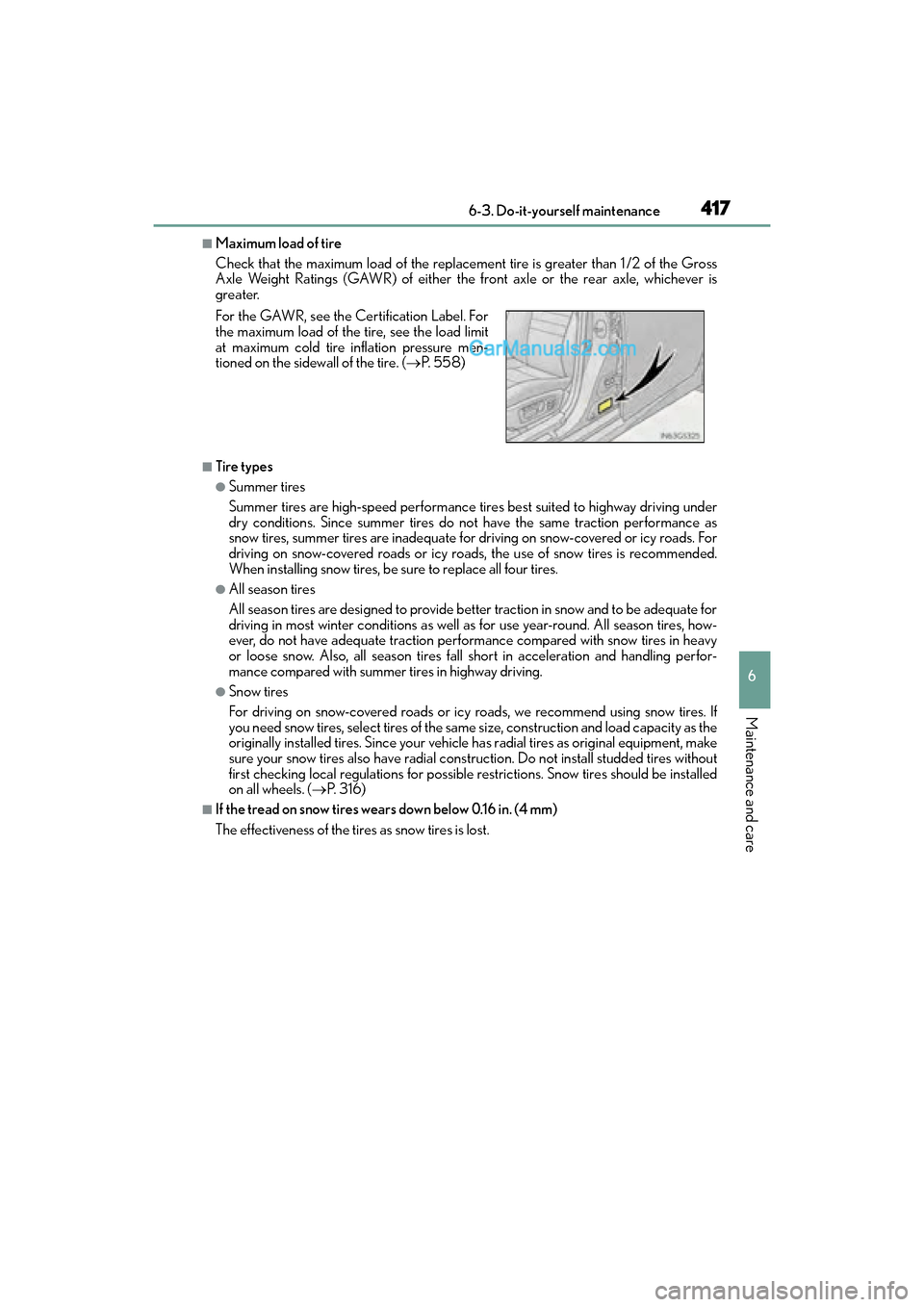
GS350_200t_GS F_OM_OM30E86U_(U)
4176-3. Do-it-yourself maintenance
6
Maintenance and care
Ō¢ĀMaximum load of tire
Check that the maximum load of the replacement tire is greater than 1 /2 of the Gross
Axle Weight Ratings (GAWR) of either the front axle or the rear axle, whichever is
greater.
Ō¢ĀTire types
ŌŚÅSummer tires
Summer tires are high-speed performance tires best suited to highway driving under
dry conditions. Since summer tires do not have the same traction performance as
snow tires, summer tires are inadequate for driving on snow-covered or icy roads. For
driving on snow-covered roads or icy roads, the use of snow tires is recommended.
When installing snow tires, be sure to replace all four tires.
ŌŚÅAll season tires
All season tires are designed to provide better traction in snow and to be adequate for
driving in most winter conditions as well as for use year-round. All season tires, how-
ever, do not have adequate traction performance compared with snow tires in heavy
or loose snow. Also, all season tires fall short in acceleration and handling perfor-
mance compared with summer tires in highway driving.
ŌŚÅSnow tires
For driving on snow-covered roads or icy roads, we recommend using snow tires. If
you need snow tires, select tires of the same size, construction and load capacity as the
originally installed tires. Since your vehicle has radial tires as original equipment, make
sure your snow tires also have radial cons truction. Do not install studded tires without
first checking local regulations for possible restrictions. Snow tires should be installed
on all wheels. ( ŌåÆP. 3 1 6 )
Ō¢ĀIf the tread on snow tires wears down below 0.16 in. (4 mm)
The effectiveness of the tires as snow tires is lost. For the GAWR, see the Certification Label. For
the maximum load of the tire, see the load limit
at maximum cold tire inflation pressure men-
tioned on the sidewall of the tire. ( ŌåÆP. 5 5 8 )
Page 420 of 628
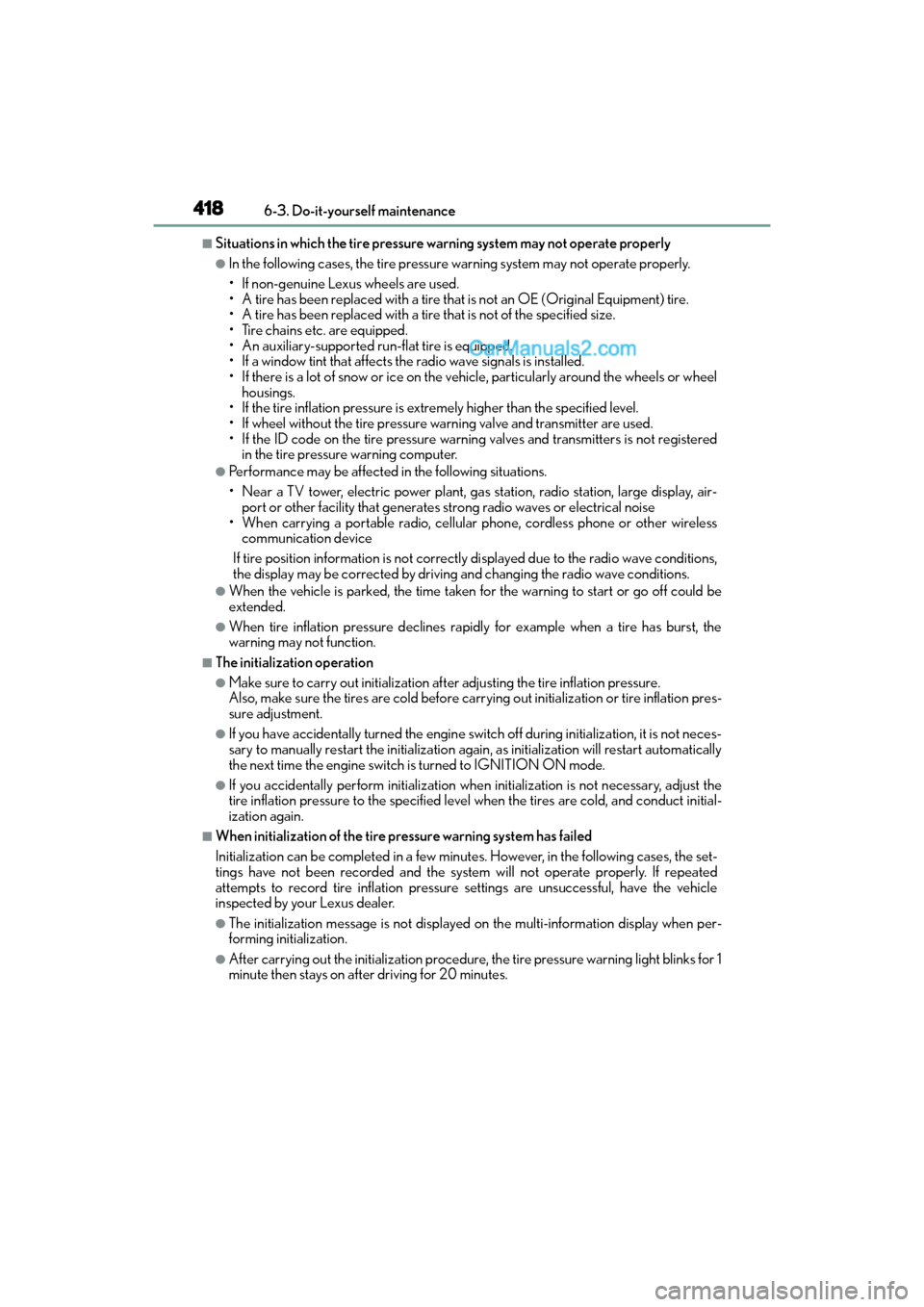
418
GS350_200t_GS F_OM_OM30E86U_(U)6-3. Do-it-yourself maintenance
Ō¢ĀSituations in which the tire pressure warning system may not operate properly
ŌŚÅIn the following cases, the tire pressure warning system may not operate properly.
ŌĆó If non-genuine Lexus wheels are used.
ŌĆó A tire has been replaced with a tire that is not an OE (Original Equipment) tire.
ŌĆó A tire has been replaced with a tire that is not of the specified size.
ŌĆó Tire chains etc. are equipped.
ŌĆó An auxiliary-supported run-flat tire is equipped.
ŌĆó If a window tint that affects the radio wave signals is installed.
ŌĆó If there is a lot of snow or ice on the vehicle, particularly around the wheels or wheel
housings.
ŌĆó If the tire inflation pressure is extremely higher than the specified level.
ŌĆó If wheel without the tire pressure warning valve and transmitter are used.
ŌĆó If the ID code on the tire pressure warning valves and transmitters is not registered in the tire pressure warning computer.
ŌŚÅPerformance may be affected in the following situations.
ŌĆó Near a TV tower, electric power plant, gas station, radio station, large display, air-port or other facility that generates st rong radio waves or electrical noise
ŌĆó When carrying a portable radio, cellular phone, cordless phone or other wireless communication device
If tire position information is not correctl y displayed due to the radio wave conditions,
the display may be corrected by driving and changing the radio wave conditions.
ŌŚÅWhen the vehicle is parked, the time taken for the warning to start or go off could be
extended.
ŌŚÅWhen tire inflation pressure declines rapidly for example when a tire has burst, the
warning may not function.
Ō¢ĀThe initialization operation
ŌŚÅMake sure to carry out initialization af ter adjusting the tire inflation pressure.
Also, make sure the tires are cold before carrying out initialization or tire inflation pres-
sure adjustment.
ŌŚÅIf you have accidentally turned the engine switch off during initialization, it is not neces-
sary to manually restart the initialization again, as initialization will restart automatically
the next time the engine switch is turned to IGNITION ON mode.
ŌŚÅIf you accidentally perform initialization when initialization is not necessary, adjust the
tire inflation pressure to the specified leve l when the tires are cold, and conduct initial-
ization again.
Ō¢ĀWhen initialization of the tire pressure warning system has failed
Initialization can be completed in a few minute s. However, in the following cases, the set-
tings have not been recorded and the syst em will not operate properly. If repeated
attempts to record tire inflation pressure settings are unsuccessful, have the vehicle
inspected by your Lexus dealer.
ŌŚÅThe initialization mess age is not displayed on the multi-information display when per-
forming initialization.
ŌŚÅAfter carrying out the initialization procedure, the tire pressure warning light blinks for 1
minute then stays on after driving for 20 minutes.